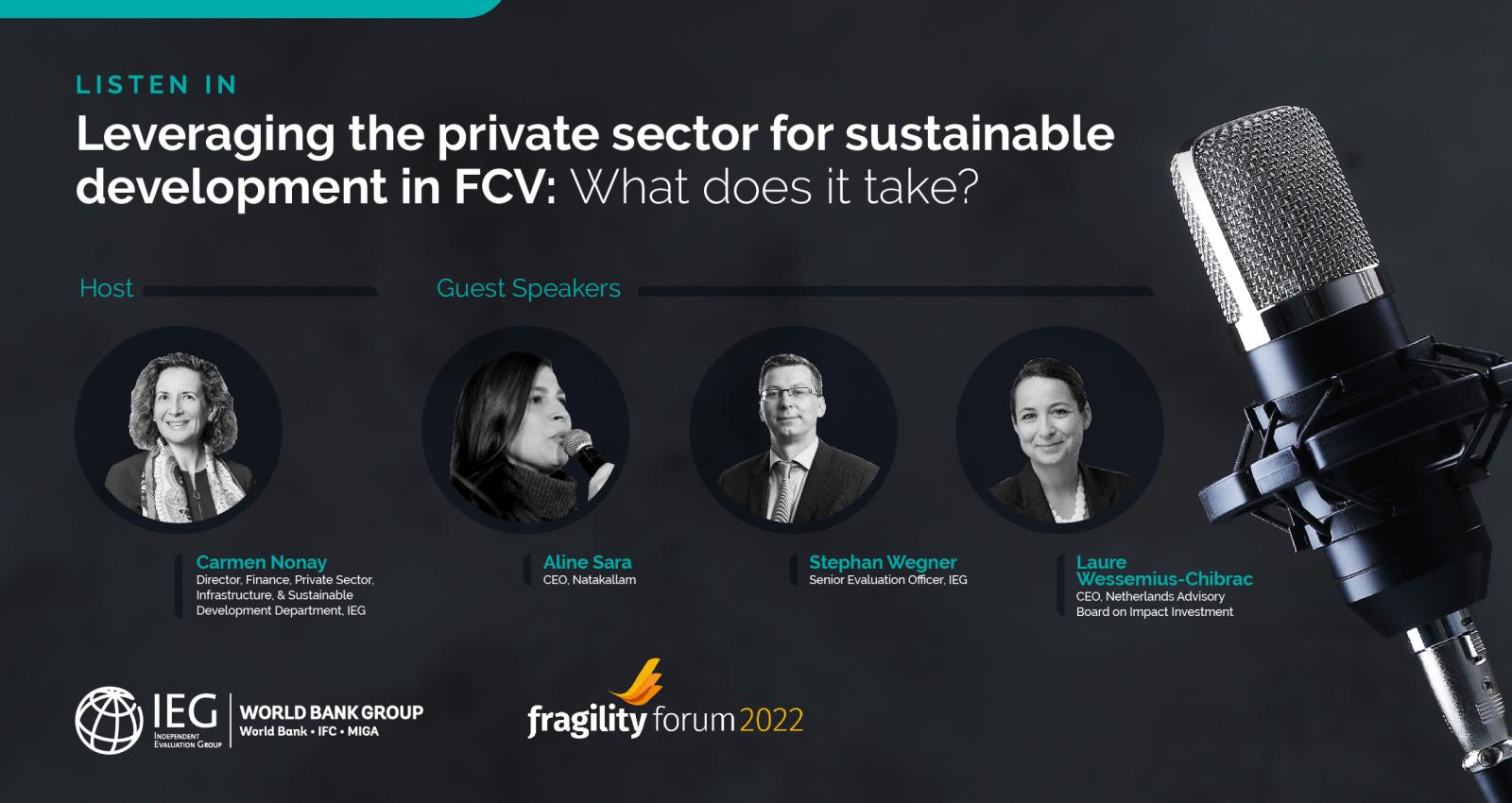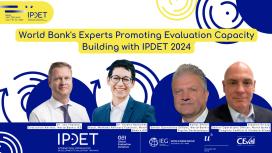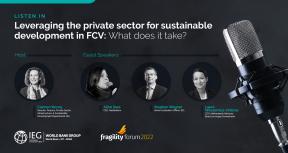Since the inception of the 2011 World Development Report (WDR 2011), the World Bank Group’s approach to Fragility, Conflict, and Violence (FCV) has emphasized the importance of job creation, especially led by the private sector, to help break these cycles of violence and fragility.
The private sector in fragile situations is often informal and highly constrained. It also faces a distorted playing field with a strong presence of Estate Owned Enterprises, for example, or entities that might be a party to a conflict.
The private sector is nonetheless a key vehicle for providing livelihoods, income, and services to people.
Carmen Nonay, IEG’s Director of Finance, Private Sector, Infrastructure, and Sustainable Development, facilitated this conversation to take stock of the lessons learned at World Bank Group after 10 years from the publication of the WDR2011, and to explore what it takes to support private sector development in fragile contexts.
Three guests joined her in conversation: Aline Sara, CEO of Natakallam; Laure Wessemius-Chibrac, CEO of the Dutch Netherlands Advisory Board on Impact Investment at the Global Steering Group for Impact Investment; and Stephan Wegner, Senior Evaluator and Fragility and Conflict Specialist at IEG.
Read the Related Report: IFC’s and MIGA’s Support for Private Investment in Fragile and Conflict-Affected Situations: Fiscal Years 2010–21
Transcript
Carmen Nonay: Can you tell us about your experience launching a business in a fragile and conflict-affected setting?
Aline Sara: Natakallam is a social enterprise that hires refugees and their host community members as online tutors, teachers and translators. Natakallam’s core goal is to provide income to refugees, no matter their location, and no matter their status in a country.
Natakallam is a digital program that operates online, with the backbone being in physical presence and in fragile states. But, because we are a double-sided market, our customers are mostly in developed countries. I think it is interesting to acknowledge that perspective.
Most of our employees are located in fragile settings, mainly in the Middle East, Sub-Saharan Africa, and in Latin America. The core of our operations began in Lebanon, supporting Syrian refugees.
Carmen Nonay: What were some of the challenges you faced and how did you overcome them?
Aline Sara: From an operational perspective, the biggest challenge has been dealing with working rights for the populations we're working with, who are mostly refugees.
Other challenges include the lack of access to a reliable Internet connection, and now to electricity, especially given the situation in Lebanon. Another challenge is figuring out payment mechanisms for the individuals we are hiring.
Funding and fundraising are a challenge as well. My experience has been less exhaustive from an investment perspective because Natakallam has mostly operated through its self-generated revenue and non-dilutive investments and grants.
I can however say that it is tricky to raise money for an operation like ours because, even though we operate within the digital economy, we are very heavily focused on hiring humans who operate and live in difficult circumstances.
There is then a problem with risks at Natakallam and certain investors are less likely to take on such risks. Add to this the fact that patient capital is less available.
I would highlight those as very operational challenges that we face working in these countries.
Carmen Nonay: Let me now turn to Stephan Wegner, our Senior Evaluation Officer here in IEG. Stephan, could you tell us more about some of the main lessons learned from your work assessing private sector development support?
Stephan Wegner: The World Bank Group and many other Development Finance Institutions have recognized that fragile and conflict-affected states require a differentiated approach to support the private sector.
They've adapted their instruments to help scale up private sector investment, and some institutions also seek to incorporate conflict analysis. But despite changing their approaches and instruments, we see little impact in terms of scaling up private sector investments.
When we looked at the portfolio of evaluated projects, we found that projects performed quite well, especially in the infrastructure sector, as well as those investments in larger countries and of larger size.
Now, among the instrument innovations that we've seen are blended finance solutions, which blend funding from public and private sector sources. These have been introduced to address financial risks that private sector investors face in high-risk markets.
One example is the IDA Private Sector Window, which was introduced in 2018 and added to the toolbox focusing on the most fragile markets where the World Bank Group offers support.
The early experience with that instrument showed some positive results in terms of allowing the private sector arms of the World Bank, IFC and MIGA, to enter new sectors in markets where they were not previously present.
We also saw that the uptake has been somewhat limited, indicating that non-financial risks might be more important than the financial risks this finance instrument is designed to address.
We are finding that the lack of a pipeline of bankable projects is a more binding constraint than the availability of finance or funds to scale up business in fragile contexts.
We've identified a couple of areas where we think Development Finance Institutions can change their business models and further adapt their toolboxes to help them achieve their strategic objectives of increasing business in fragile conflict-affected situations.
The first one is the heterogeneity of countries. Differences in country conditions call for differentiated strategies that are based on a thorough analysis and diagnostic of opportunities and constraints in those countries, building on an understanding of the drivers of fragility and conflict.
The second area is the limited number of clients with which these institutions are used to work. This implies a need for these institutions to go beyond their client base to more informal, less experienced clients. It requires more patience, capacity building, and a hand-holding type of approach to them.
What we found in our work is that many projects were linked to upstream work through efforts to reform a sector and provide capacity building and advisory services that have facilitated the development of a pipeline of bankable projects in fragile settings. We see this evidence as a promising approach to increase the pipeline towards increased efforts in fragile and conflict-affected states.
Supporting private investments in fragile contexts is very expensive. It involves higher costs of doing business, longer time horizons for generating projects, and the patient capital that Aline was referring to earlier.
Overall, we are still learning which models and approaches are effective in fragile contexts. Supporting private sector activities requires continuous experimentation, the adaptation of approaches and models, and learning as we go along.
Carmen Nonay: Let me now turn to Laure. What are some of the lessons that you have learned in your role as CEO of the Dutch Netherlands Advisory Board on impact investing? And, looking into the future, what do you think it will take to increase the pipeline of bankable projects in fragile and conflict-affected situations?
Laure Wessemius-Chibrac: I'm responding as CEO of the Netherlands Advisory Board on Impact Investing, but also with a couple of other hats on: I used to be the Managing Director of the investment branch of Cordaid, the NGO based in the Netherlands, and they've had the chance to work a lot in conflict-affected states and in fact that’s where they particularly focus on.
I'm completely in line with what Stephan said a little bit earlier about the various points regarding the immense complexity of the situation and the fact that you need a lot of flexibility and adaptability to be able to work in this context.
When I was at Cordaid, we were active in different countries over 3 continents and not one context was similar to the other. This underscores the point that we, as a foundation, had the flexibility to adapt our business model and investment strategy to various contexts. That was a big change for us and it’s not always easy to achieve for development finance institutions.
Stephan also mentioned the need for capacity building, and I could not agree more. This is connected to your second question regarding how to increase the pipeline of bankable projects. In many of these contexts, the informal sector accounts for anywhere between 50% to 90% of the economic activity. So it's very difficult to invest and increase the pipeline if you do not ensure that there's a gradual building of this pipeline at several levels.
In previous conversations with Stephan and the evaluation team, I have always asked the question: what is a bankable project? And I'm pretty sure that if you ask various types of investors, you're going to have many different answers. And I'm sure that for IFC and MIGA, the definition would be slightly different than that from a foundation like Cordaid.
The word bankable is often associated with risk-adjusted returns. But when, as Stephan mentioned, the cost of doing business in fragile contexts is 2.5 times more expensive than in other developing countries, how can you ever have a return that is actually adjusted to the risk?
One of the big lessons learned, in our experience, is that you need to diminish the risk where you can, and this brings me to the topic of foreign currency and local currency. We have wonderful instruments offered by currency funds, but unfortunately, the burden of the costs of the hedging very often is borne by the enterprise that we're financing. This results in unbearable costs.
What we've learned is that by trying to innovate on solutions, decreasing the costs is actually a good way of increasing the number of bankable projects just because they have reduced risk and they have a more acceptable level of return.
Working on the capacity is a very important point, especially if you try to build a pipeline with more informal sector participation. It needs time and patience.
Aline talked about patient capital earlier and I couldn't agree more. You can't look at quarterly results when you expect to trigger long-term change in certain situations.
The approach as an investor is very different when arriving in fragile and conflict-affected states. If you focus on these situations, you know that there are inevitable cycles of crisis that come again and again and again. And you know you need to be prepared for these crises, and when you have a large organization like IFC, you can be very diversified, which is a great tool to have.
Having a portfolio approach towards your investments is worth mentioning because if investors decide to invest in a pool of countries, they can be prepared to maybe make some losses with some of them, or some sectors. For instance, I heard Stephan mentioning that projects in the infrastructure sector are performing well, so if investors are performing well on that part of their portfolio, they might be more accepting of making losses on other parts of their portfolio.
Carmen Nonay: Now I'd like to turn to Aline. You have heard some of IEG's analysis and that of an impact investor. Do these findings and proposals resonate with you as an entrepreneur? And what will it take to scale up social enterprises like yours?
Aline Sara: You know everything I've heard strongly resonates with my experience.
I chose, as the founder of a small social enterprise, not to typically seek investments. As I mentioned, Natakallam has grown from its operations and its self-generated revenue as well as from a combination of non-dilutive grants from foundations, competitions that we've won, etc.
From our perspective, as a 6-year-old enterprise, we made a deliberate choice to not go to investors because we knew that they would see too much risk in the work we're doing. They would also not necessarily be ready to wait for us to get to a better point after investing in us.
Things might have changed in the interim now. Natakallam continues to grow and we're now looking at impact investments, which I think is itself a term that is sometimes thrown around a little bit loosely and can be looked at in a different way.
But this resonates with our experience which is why today Natakallam has not gone for investments yet. Perhaps that will change.
I feel like we haven't talked about impacts as much, right?
I'm hearing more about the risks from the investor’s perspective, and I feel that sometimes the impact gets lost in the discussion. Natakallam prides itself on being an impact-first for-profit social enterprise, which itself is something that is a complicated topic.
But one thing I find is sometimes missing from the discussion is what does impact mean?
Laure raised a very good point by pointing to the meaning of a bankable project and as she was speaking I quickly Googled the definition. The first thing that came up is very often used in the Hollywood sector, or the entertainment sector, for a project that's going to bring back return and success.
How does one define success for social enterprise? Are we talking about the returns on investment or are we talking about the impact?
What is deep impact versus breath of impact?
These are all topics that I sometimes find aren't addressed enough.
Everything that I heard Laure pointed out to is the risks, the fluctuations, and the uncertainty when you're operating in fragile states.
I mean half of the refugees we work with were affected by the Beirut bombings and from one day to the next we lost our payment mechanism to Beirut, where the entire banking sector crumbled, and even the wealthiest of Lebanese could not pull out their money.
So it's a very different ball game when you are investing in fragile States and investors have to be ready to put a whole other level of skin in the game.
Carmen Nonay: Laure, you have heard Aline talk about a call for the redefinition of bankable. What is your reaction to that?
Laure Wessemius-Chibrac: It's interesting that she considered that her enterprise presented too much risk and she was hesitant to attract investors. I understand that and also see that there are more and more investors asking about what return they can expect. We talked a lot about risk-adjusted returns, but some investors, impact investors, are asking about fair returns.
Particularly in asset classes such as private equity, where investors often expect double-digit returns and multiples, you start realizing that in reaching those returns they negatively impact their employees or their customers, either because customers overpay for their services or their products, or because employees are underpaid.
I think that's also part of the redefinition of what is bankable and what our returns and what are fair returns.
Carmen Nonay: Thank you for joining us for this conversation and to explore more evidence and lessons learned on what works, what doesn't, and why.






Add new comment